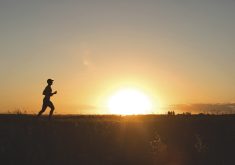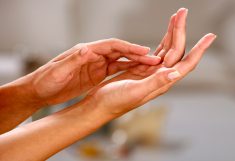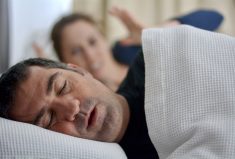Most people hope to spend their later years living independently and doing the things they love.
Unfortunately, it doesn’t just happen. All of us may need to invest in strength training today to make that vision a reality in the future, says Dr. Lora Giangregorio.
According to Giangregorio, falls are the number one cause of injury and hospitalization in older adults. The statistics paint a dismal picture. Each year, 20 to 30 per cent of older adults experience falls. It’s important, because more than a third of seniors will move into long-term care after experiencing a fall that requires hospitalization.
Read Also

Employment Agreements Can Help Protect Your Farm
Entering into employment agreements with each of your farm employees should be at the top of every farm’s “to do” list, but caution must be exercised.
By taking action today, however, we can decrease our risk of a fall and the loss of mobility and independence that can go with it, says Giangregorio.

Giangregorio is a professor and the Schlegel research chair in mobility and aging at the University of Waterloo. One of her areas of study is the effect of exercise for reducing fracture risk.
Research has shown that we start losing muscle mass and bone mineral density at a rate of between a half a per cent and one per cent per year beginning in middle age. Unfortunately, we may not notice these incremental losses until we are older and start to experience difficulties.
People often think declining ability is inevitable, but Giangregorio says her research shows that a multi-component exercise program that combines muscle strengthening and balance training can significantly reduce the risk of falls and, potentially, the resulting fractures.
The news is good because these benefits can be obtained with as little as one hour, twice a week.
One of the biggest misconceptions, Giangregorio says, is that “people conflate being busy with being physically active, but we’re not necessarily doing things that preserve muscle, bone and balance,” she says.
While walking, gardening and other active pursuits are good, she says a muscle strengthening program that targets all of the major muscle groups two to three times a week, and includes balance training, is also necessary.
The good news is that it’s never too late to get started. In her research, Giangregorio says older adults with mobility issues or other health concerns showed improvement after starting a targeted exercise program. “You can almost always get a bit stronger.”
But Giangregorio emphasizes it is better to start before you develop health and mobility issues.
It’s an investment in your future and in being able to live the kind of lifestyle you want, she says.
So, what kinds of exercises should we be doing to preserve muscle, bone and balance?
Working with an exercise physiologist (one with certification through the Canadian Society for Exercise Physiology) to design a custom program would be the ideal scenario but Giangregorio knows this isn’t practical for everyone.
Alternatively, she says, you could sign up for community exercise classes that teach strength and balance training or you could design your own at-home fitness program (see resources listed at the end of this article).
There is evidence that practicing Tai Chi can help reduce fall risk, says Giangregorio, but yoga, which can be quite variable, has not been well studied.
If you want to get better at climbing stairs without fatigue, Giangregorio recommends practising step-ups. If you want to get better at bending and lifting in the garden, do squats, deadlifts and lunges. These are sometimes called functional exercises because they mimic the movements we make in our daily lives and are aligned with the individual’s goals.
Functional strengthening exercises include several categories: squat (to strengthen upper legs and lower legs), push (for chest and arms), pull (upper back and arms), reach or press overhead (arms, shoulders, upper back), carry (whole body including abdominals and back extensors, and forearm muscles), and hinge (upper legs and lower legs).
Giangregorio says the specific exercise a person should choose will depend on their current ability. For example, a person who is not very strong and needs a beginner push exercise might do a wall pushup. Someone who is stronger might do a counter pushup or one on the floor. These are all variations of push exercises.
Here are some additional tips for adopting a strength and balance training program from Giangregorio:
- The exercise program should be progressive or get more challenging over time. This will help you see improvements and it will keep the program interesting.
- You should feel fatigued by the end of each set.
You can break your exercise up into multiple sessions by exercising the major muscle groups in the upper body one day and the lower body another day, as long as you do exercises for each muscle group twice per week.
Giangregorio likes to work out in a gym but she says it’s also possible to create a workout at home. Instead of free weights, you could use jugs of vinegar, for instance.
If choosing to join a gym, it should be one where you feel welcome and comfortable. It should be accessible, have the equipment you need and also employ trained staff to support you.
Not surprisingly, people start with every intention of making a habit out of their strength and balance training program but then fail to follow through.
To improve your success rate, Giangregorio recommends making a simple plan. The plan should include written goals of how, where and when you will do the activities and also a contingency plan if you miss a day.
Be sure to monitor your follow-through. Keep track by making a simple checkmark on a calendar.
Also remember that enlisting supports such as a workout buddy or family support can help with motivation.
It can be challenging to make an exercise program a habit, Giangregorio acknowledges.
In her experience, though, people who stick with it are glad they did. So, if you’re really having trouble, she suggests you commit to exercise for just 10 minutes. Find your path to that healthy future!
Resources
- Dr. Lora Giangregorio’s website or follow The Bone health and Exercise Science lab on YouTube or Facebook.
- If you have had falls in the past year, and want a beginner program to get started, here is information about the Otago Exercise Program.
- For those in the Waterloo, Saskatoon or Toronto area, Giangregorio is looking for participants aged 50 or older who have low bone density, osteoporosis or osteopenia to participate in a one-year study called the Fortify Bones Study offered by the University of Waterloo. For more information, call 519-904-0660 ext. 4222 or email [email protected].
















